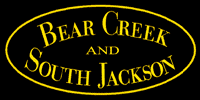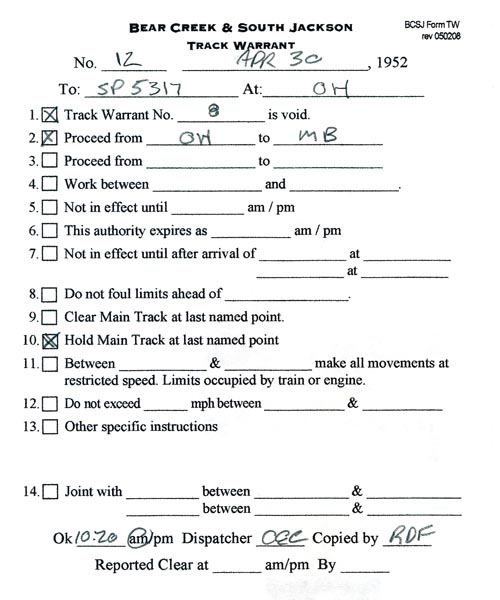Radio Protocol
Here's a quick example of the conductor of the Bear Creek Hauler East in Salem
requesting a track to run to South Jackson. The conducotr waits for a break in the
radio chatter then:
Conductor: Bear Creek dispatch this is SP5334 at Salem. Over
Dispatch: Go ahead SP5334. Over
Conductor: We are the Bear Creek Hauer East requesting a track warrant
to run to South Jackson. Over
Dispatch: SP5334 how many loco and cars do you have? Over
(the DS needs this information to know where he can have BCHE meet other trains).
Conductor: SP5334. We have two SD7s pulling 24 cars including caboose. Over.
Dispatch: SP5334. Are you ready to copy a warrant? Over
Conductor: SP5334. Ready to copy. Over.
Dispatch: SP5334. This is track warrant number 13 dated March 17, 1952.
To Espee 5334 at Salem, Checkbox 2. proceed from Salem to Oakhill. Checkbox 9. clear main track at last
named point. Over
Apparently there is a west bound coming up the hill so the DS wants to put us in the hold at
Oakhill for the meet.
Conductor: SP5334. Reading back warrant number 13 dated March 17, 1952.
To Espee 5334 at Salem, checkbox 2. proceed from Salem to Oakhill. Checkbox 9. clear main track at
last named point. Over.
Dispatch: SP5334. That is OK at 11:07 am dispatcher JQR. Over
Conductor: SP5334. OK at 11:07 am dispatcher JQR. Copied by TDF. Over and out.
Train BCHE is now authorized to proceed from Salem to Oakhill. At Oakhill it will
head into the siding. Once in the clear the conductor will call the dispatcher again to
report being in the clear and ask for anothe warrant.
Conductor: Bear Creek dispatch this is SP5334. We are in the clear at
Oakhill and are ready to copy another warrant. Over
Dispatch: SP5334 this is dispatch. This is track warrant number 16 dated March 17, 1952.
To Espee 5334 at Oakhill, Checkbox 1. track warrant number 13 is void. Checkbox 2. proceed
from Oakhill to South Jackson. Checkbox 7. Not in effect until after arrival of BCSJ 32 at Oakhill.
Over
BCHE is getting a warrant conditional on the arrival of the train they are to meet at Oakhill.
In this case they should expect to see a train pulled by BCSJ 32 show up. After BCSJ 32 (and train)
have pulled completely past the Oakhill west end turnout, BCHE can depart for South Jackson.
Because South Jackson is within yard limits BCHE's crew will need to call the yard master before
entering the yard.
Conductor: Bear Creek dispatch this is SP5334. Reading back track warrant
number 16 dated March 17, 1952.
To Espee 5334 at Oakhill, Checkbox 1. track warrant number 13 is void. Checkbox 2. proceed
from Oakhill to South Jackson. Checkbox 7. Not in effect until after arrival of BCSJ 32 at Oakhill.
Dispatch: SP5334. That is OK at 11:49 am dispatcher JQR. Over
Conductor: SP5334. OK at 11:49 am dispatcher JQR. Copied by TDF. Over and out.
After BCSJ 32 shows up BCHE can proceed from Oakhill to South Jackson. After finishing their
work in South Jackson the conductor will need to get another warrant to authorize their
trip to Pocatello.
To top.



